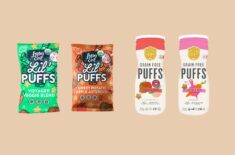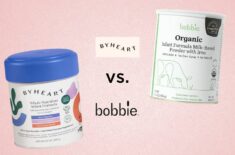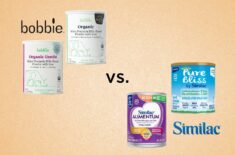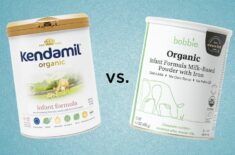Overview
Studies show that eating strawberries and blueberries at least three times a week can improve heart health. (1)(2)
Strawberries are packed with vitamin C, which can support the immune system. They also contain magnesium, potassium, and bioactive compounds that can help reduce the risks of cancer, heart disease, and diabetes. (1)(2)(3)
Those are certainly reasons enough to consider adding these nutritious berries to your baby’s diet.
Strawberries are also soft and can be a good pick in BLW (baby-led weaning) if they’re prepared properly.
How do you cut strawberries for baby-led weaning? Can you offer these to a six-month-old baby, and do you have to cook them? What baby food recipes can you make with this ingredient? Are there safety issues with strawberries?
You can find more information below.
What’s BLW?
Coined by pioneer Dr. Gill Rapley, baby-led weaning is a feeding approach that encourages babies to eat healthy finger food at their own pace. (4)
They get to feed themselves with whatever and how much food they want. As a parent or caregiver, your main role is to offer them opportunities to eat these healthy foods.
Can Babies Have Strawberries In BLW?
Yes. Strawberries and other berries are among the top sources of vitamins and important nutrients to help boost our immune system. They can be a great choice as BLW food.
Fresh strawberries are ideal, but you might still find frozen strawberries in nearby grocery stores if they aren’t in season. They can be as nutritious as the fresh ones.
If possible, choose organic strawberries because studies show that they can be safer and have better health properties than conventionally grown products. (5)(6)
Top Reasons To Serve Strawberries In BLW
Nutrition Facts
These berries are rich in the following nutrients:
- Vitamin C
- Vitamin A
- B vitamins
- Vitamin K
- Zinc
- Dietary fiber
- Manganese
- Folate
- Potassium
- Phosphorus
- Calcium
- Omega 3 fatty acids
- Copper
- Magnesium
- Antioxidants (compounds that protect cells from free radicals)
They’re nutritious and can be easy to prepare. You can offer strawberries as baby food purées or finger foods in baby-led weaning. They’re also freezer-friendly.
Below are some of the benefits of strawberries in baby-led weaning.
They Can Boost Immunity
Studies show that bioactive compounds in strawberries can help boost the immune system. (7)(8)
These berries are packed with vitamin C, known for immune-boosting, anti-inflammatory properties. (3)
Your baby’s immunity system is their first line of defense against diseases.
They Can Promote Heart Health
The bioactive compounds can also lower the risk of heart disease. (7)
Eating strawberries and blueberries at least three times a week can help improve heart health, according to data gathered from 93,600 participants. (1)(2)
One of the researchers in this study, Dr. Eric Rimm of Harvard School of Public Health and Harvard Medical School, shares the highlights of their study results:
“The sooner people start the type of diet that includes a higher intake of blueberries and strawberries, the better.
The people with heart benefits had three or more servings of a half a cup of blueberries or strawberries each week.” (2)
They Might Have Anti-Cancer Properties
Some studies show that antioxidants (substances that protect cells from free radicals) found in strawberries, such as quercetin and anthocyanins, plus vitamin C and other minerals, might play a crucial role in cancer prevention. (3)(7)
They Can Promote Brain Health
A diet rich in strawberries can also help promote brain health and boost memory. These can be due to the nutrients such as vitamin C, folates, minerals, and various bioactive compounds found in this fruit. (3)(9)
They Can Promote Digestive System Health
Strawberries are also rich in fibers that can help improve your baby’s digestive system. They can also help promote digestion and inhibit inflammation.
Studies show that their bioactivity can increase the number of good bacteria in the tummy. (10)(11)
They Can Have Anti-Allergic Effects
The abundant antioxidants (such as quercetin) in strawberries might have anti-allergic and anti-inflammatory effects. These bioactive compounds could be the reason why strawberry allergies might be rare. (8)
They Can Help Improve Eyesight & Protect Eyes
The following vitamins and bioactive compounds are found in strawberries that can help improve eyesight and protect your baby’s eyes from the effects of harmful free radicals: (12)
- Vitamin C
- Vitamin E
- Vitamin A from beta-carotene
- Zinc
- Lutein
- Omega-3 fatty acids: EPA (eicosapentaenoic acid) and DHA (docosahexaenoic acid)
They Can Fight Scurvy
Abundant in vitamin C, strawberries can help fight scurvy, a condition caused by the severe lack of this vitamin in someone’s diet. Scurvy can cause weakness, bruising, gum problems, tooth loss, and bleeding. (13)
Although scurvy is currently rare in the US, studies show that it’s still observed in Canada and many developing countries. (13)(14)(15)
They Can Promote Bone Development And Growth
Strawberries are also good sources of calcium. Your baby’s fast-growing body needs plenty of calcium to develop and grow strong bones. (16)
They Can Help Improve Metabolism
These berries are rich in folate, an essential nutrient that can help improve metabolism, transforming carbohydrates in food to energy. It’s important in healthy cell growth and function. (17)(18)(19)
Food Safety With Strawberries
Is Strawberry A Choking Hazard?
Small, round fruits that are firm and hard can be potential choking hazards. So, avoid giving small strawberries about the size of a grape or smaller to your baby.
Smash or cut these small-sized strawberries into small pieces or thin strips to minimize choking risks.
You can serve large strawberries bigger than a golf ball without cutting, but check to ensure they’re soft and ripe to avoid choking hazards.
You can create a safe eating environment for your child by choosing a sturdy highchair with footrests.
Also, it’s best to stay within an arm’s reach of your baby throughout mealtimes and avoid distractions. It can help you monitor your child for possible choking incidents.
You can learn more about choking in BLW and how to minimize hazards in our article.
Is Strawberry An Allergen?
No. Strawberry isn’t considered a common allergen, although allergenic proteins in the strawberry fruit have been identified. (20)
However, some studies show that strawberries can still cause an allergic reaction in some people. But strawberry allergy remains rare. (20)
It’s also possible that your child’s allergic reaction to strawberries isn’t a true strawberry allergy but a part of the PFAS (pollen food allergy syndrome).
They might develop an allergic reaction not just to strawberries but also other fruits:
- Apples
- Grapes
- Plums
- Cherries
- Kiwi
- Melons
- Persimmons
- Tomatoes
- Mangoes
- Bananas
These allergic reactions are also known as oral allergy syndrome. They usually have oral symptoms, such as itching or a tingling, burning sensation in the mouth, lips, and/or tongue. (21)(22)
Researchers note that these allergic reactions might be experienced more with raw fruits and veggies. Cooking them might reduce the allergens because heat can distort the proteins. (21)
Still, be sure to consult with an allergy specialist or your pediatrician if your child experiences a reaction to the fruit.
According to consultant dermatologist Dr. Sandy Flann, berried fruits like strawberries and citrus can worsen eczema (red, itchy skin often caused by an allergen). (23)(24)
Sometimes, however, the tingling sensation felt around the mouth might not be an allergic reaction but a skin reaction from the fruit’s acidity. These are regular, organic acids found in fruits. (25)
Some blogs claim that white strawberries can be less allergenic than colored ones because they supposedly lack the allergenic proteins (Fra a proteins) that also give them their color. But studies show that white strawberries may not be hypoallergenic. (26)(27)
Why Can’t Babies Have Strawberries?
For years, non-organic strawberries continually topped or belonged to the “Dirty Dozen” list released by the EWG (Environmental Working Group) for the 12 foods with high pesticide residues. (28)
According to the EWG, strawberries can contain an average of 7.8 different pesticide residues per sample. It’s several times the average of 2.2 in all other types of produce. (29)
What’s even more alarming is that 99% of all samples had detectable levels of at least one pesticide, with the dirtiest samples showing residues of 20+ different pesticides. (29)(30)
Many of these pesticides might not directly affect human health. But the EWG points out that some, such as Carbendazim and Bifenthrin, can be carcinogens or cause damage to the male reproductive system. (29)
Still, strawberries are nutritious foods and have plenty of benefits. Instead of avoiding them, the EWG recommends choosing organic products.
Organic strawberries might cost more than conventionally grown products, but the EWG says that it’s a small price to pay for food safety. (29)
Studies show that organic strawberries can be safer and healthier than non-organic products. (4)(29)
You can still choose non-organic strawberries but be sure to wash them thoroughly.
Soaking fruits or vegetables in a baking soda solution (1 tsp baking soda for every 2 cups of cold water) for 15 minutes can help remove surface pesticide residues, but peeling can also be more effective. (31)
Can I Give Strawberry Jam To My Baby?
Many people love strawberry jam, but you might want to hold off giving this sweet treat until your baby is two years old. Jam can be packed with plenty of added sugars, with many store-bought products containing preservatives.
Too much sugar and sweets can promote obesity. (32)
Instead of choosing jam, you can opt for mashed or puréed fresh strawberries for your baby.
When Can Babies Eat Strawberries?
The Dietary Guidelines for Americans include strawberries among the foods they recommend for regular consumption. Fruits can be eaten fresh, canned, or frozen.
These fruits are soft enough to be picked as one of your baby’s first foods. They can eat it when you start introducing them to solid foods at around six months of age.
Babies develop at their own pace and timeline. Some babies might be ready for solids by four months old, but others might develop later and can only be ready when they’re closer to their first birthday.
So, age shouldn’t be the only factor to consider when determining whether you can give them solid food.
In deciding when to give them their first solid foods, you can check for signs that they’re ready to eat.
Signs of readiness can include sitting up (with or without help) and showing interest in food, such as grabbing at food or leaning towards it.
Always ensure your child is ready before you introduce them to solid foods. You can ask your pediatrician for recommendations and help determine your baby’s readiness, especially if they’re below six months old.
You can find other signs of readiness to check, plus tips on what foods to give your baby in our guide for baby-led weaning foods.
Can We Give Strawberries To A Six-Month-Old Baby?
Yes. Strawberries can be a nutritious first food for your six-month-old baby.
However, because they can be a potential choking hazard, be sure to prepare them based on your child’s age.
You can find more information about the best cuts and sizes for different ages below and in our article on baby finger foods.
How To Introduce Strawberries To Your Baby
To help check if your child has allergies to certain foods, you can offer them in small quantities at first. If they don’t react to these new foods, you can gradually serve them more in future meals.
Some pediatricians might recommend introducing one food at a time so you can monitor which ones can cause an allergic reaction in your little one.
Ways To Serve Strawberries In BLW
- Puréed strawberries, smooth or lumpy
- Mashed strawberries
- Sliced strawberries, with or without coating
- Homemade muffins
- Strawberry oatmeal
You can offer your baby finger foods made from strawberries, but they can still enjoy the fruits as a purée in baby-led weaning.
Your baby can self-feed by dipping their fingers in puréed strawberries. Another option is for your baby to use them as a dip for other finger foods.
Check out some BLW strawberry recipes below.
Do You Have To Cook Strawberries For Your Baby?
No. Ripe strawberries are soft enough to be eaten raw, but you have to make sure they’re sliced properly to reduce choking risks.
Still, if you’re concerned about potential allergens in your baby’s first foods, you can cook strawberries before offering them to your child.
Studies show that those with oral allergy syndrome, such as those allergic to strawberries, can usually eat these fruits or vegetables in cooked form. The heating process distorts the allergenic proteins, so the immune system might no longer recognize them as an allergen. (21)
Steps to steam your strawberries:
- Put the sliced strawberries in a steamer.
- Cook for 4-5 minutes.
- Drain in a colander or strainer.
- Immediately rinse with cold water for three minutes. It cools the fruits and stops the cooking process.
How Do You Prepare Strawberries For Baby Led Weaning?
Choose Organic
In buying fresh strawberries, look for fruits free from bruises, scratches, or other blemishes. It’s also important to avoid moldy or overly soft strawberries.
If possible, it can be a good idea to choose organic in buying strawberries because non-organic options can contain many pesticide residues. (29)
Washing Is Important
When organic strawberries aren’t feasible, you can still choose non-organic ones. However, wash them several times and soak them in a solution with baking soda for around 15 minutes.
Soaking them in a baking soda solution can help remove surface pesticide residues. (31)
After soaking, rinse thoroughly in running water and dry.
Thaw Frozen Strawberries
If you’re using frozen strawberries, thaw them first. Drain any excess liquids before offering your child or using them in your recipe.
How Do You Cut Strawberries For Baby-Led Weaning?
In preparing your baby’s food, you can remove the stem before cutting them. Here are our suggestions for cutting strawberries according to your baby’s age:
For 4-6 Months Old
You can directly give a whole strawberry to your baby if you have a large, ripe fruit bigger than a golf ball. They can gnaw and suck on the fruit.
But if they manage to eat much of the fruit, ask them to give you the small piece. Replace with another whole strawberry or offer other food options.
For smaller strawberries, you can slice them in half. Be sure it’s in a size that can’t block their airways if they swallow them whole accidentally.
However, if your child is still below six months old, it’s a good idea to ask your pediatrician before introducing any solid food to your baby.
For 6-12 Months Old
You can continue giving whole strawberries to your baby at this age, but ensure these are ripe and bigger than a golf ball to minimize choking risks.
If your baby has developed their pincer grasp at around eight to nine months old, you can dice the strawberries for them to pick up. However, the pieces should be small to avoid choking if they swallow these accidentally.
Continue to mash or slice smaller strawberries (smaller than a golf ball) into small pieces before offering them to your baby.
For 12+ Months Old
You can try offering your child small, bite-sized slices of strawberries to pick up with their fingers. Your toddler might also be interested in using a spoon and fork at this age. They can use those to pick up their sliced strawberries.
Again, you can serve whole strawberries when they’re larger than a golf ball, but for smaller ones, slice thinly or quarter them.
To learn more about other foods for your baby, you can also read our guide on BLW foods by age.
How To Store Strawberries
In storing your strawberries and any food made with these fruits, be sure to put a label with the date. It can help you keep track of their expiry dates.
Still, check for signs of spoilage, including bad odor or molds, before giving these stored foods to your baby.
Purées
- You can pour homemade purées into an ice cube tray or small airtight containers, then freeze them for up to three months.
Finger Foods
- Put in an airtight container.
- Store in the fridge.
- These can last for up to three days.
2 Super-Easy Strawberry Recipes To Try
Sliced Strawberries & Cream
Ingredients
- One or two pieces of large organic strawberries (fresh or frozen)
- Organic yogurt (coconut yogurt or cow’s yogurt is fine if you’ve already introduced dairy)
- Toppings, such as hemp seeds (optional)
Preparation Instructions
- Slice strawberries into quarters for older babies (around 8+ months) or half if your little one is still around six months old.
- Place the strawberries on top of a dollop of yogurt.
- Add the toppings (optional).
- Serve
Strawberry Oatmeal
Ingredients
½ cup organic strawberries (fresh or frozen)
½ cup dry rolled oats
1 cup water or milk (breastmilk, formula, dairy-free milk, etc.)
A pinch of ground cardamom, nutmeg, cinnamon, etc. (optional)
Preparation Instructions
- Cook the oatmeal in water for about five minutes.
- Constantly stir until it thickens.
- Once cooked, remove from the fire.
- Cool.
- Mash half of the strawberries. Mix it with the oatmeal.
- Sprinkle the spice of your choice (optional).
- Cut the rest of the strawberries in age-appropriate sizes. Serve separately.
You can let your baby self-feed oatmeal using their fingers or put a preloaded spoon for them to hold.
They can also enjoy the sliced strawberries while they eat their oatmeal.
You can also mix in other ingredients, including smashed blueberry, and slices of kiwi or pineapples.
REFERENCES
(1) https://pubmed.ncbi.nlm.nih.gov/28606222/
(2) https://www.health.harvard.edu/heart-health/eat-blueberries-and-strawberries-three-times-per-week
(3) https://pubmed.ncbi.nlm.nih.gov/24450925/
(4) http://www.rapleyweaning.com/assets/How_early_is_too_early.pdf
(5) https://www.ncbi.nlm.nih.gov/pmc/articles/PMC7143540/
(6) https://www.ewg.org/foodnews/strawberries.php
(7) https://pubmed.ncbi.nlm.nih.gov/15077879/
(8) https://www.ncbi.nlm.nih.gov/pmc/articles/PMC6273625/
(9) https://www.ncbi.nlm.nih.gov/pmc/articles/PMC4192974/
(10) https://www.ncbi.nlm.nih.gov/pmc/articles/PMC6490960/
(11) https://pubmed.ncbi.nlm.nih.gov/30810035/
(12) https://www.ncbi.nlm.nih.gov/pmc/articles/PMC3693724/
(13) https://medlineplus.gov/ency/article/000355.htm
(14) https://www.ncbi.nlm.nih.gov/pmc/articles/PMC7858707/
(15) https://www.ncbi.nlm.nih.gov/pmc/articles/PMC5914469/
(16) https://pubmed.ncbi.nlm.nih.gov/27583710/
(17) https://www.mayoclinic.org/drugs-supplements-folate/art-20364625
(18) https://pubmed.ncbi.nlm.nih.gov/12502396/
(19) https://pubmed.ncbi.nlm.nih.gov/19706971/
(20) http://www.jiaci.org/revistas/vol30issue4_6-2.pdf
(21) https://acaai.org/allergies/allergic-conditions/food/pollen-food-allergy-syndrome/
(22) https://pubmed.ncbi.nlm.nih.gov/18788424/
(23) https://sandyflann.com/2012/07/12/strawberries-and-eczema/
(24) https://nationaleczema.org/eczema/
(25) https://www.ncbi.nlm.nih.gov/pmc/articles/PMC6657712/
(26) https://www.ncbi.nlm.nih.gov/pmc/articles/PMC5486009/
(27) https://pubmed.ncbi.nlm.nih.gov/28873746/
(28) https://www.ewg.org/foodnews/dirty-dozen.php
(29) https://www.ewg.org/foodnews/strawberries.php
(30) https://pubmed.ncbi.nlm.nih.gov/24303788/
(31) https://pubmed.ncbi.nlm.nih.gov/29067814/
(32) https://www.ncbi.nlm.nih.gov/pmc/articles/PMC6959843/












